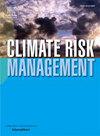Ex-ante and ex-post adaptation: Farmers’ fertilizer strategies for extreme weather events in China
IF 5
2区 环境科学与生态学
Q1 ENVIRONMENTAL SCIENCES
引用次数: 0
Abstract
This study investigates farmers’ fertilizer strategies as ex-ante and ex-post adaptations to extreme weather events in China. Using plot-level data from 778 maize farmers across three provinces collected in 2015 and 2018, we employ two-way fixed effects models to analyze how farmers adjust fertilizer quantity both before and during the growing season in response to floods, droughts, and windstorms. The results show that farmers increase ex-ante fertilizer application under flood risk but reduce input when anticipating drought and windstorm risks. After disaster shocks, they supplement fertilizer as an ex-post coping strategy. Heterogeneity analysis reveals that smallholders and nitrogen fertilizers are more sensitive to extreme weather, and that the effects of disaster severity are nonlinear and vary by disaster type. Mechanism analysis suggests that ex-ante fertilizer use can mitigate flood risk but may increase vulnerability to drought and windstorms, whereas ex-post use broadly aids recovery. Extended analysis uncovers a substitution effect between public interventions and private adaptation. These findings provide micro-level empirical evidence and policy insights for balancing food security and environmental sustainability amid rising extreme weather.
前后适应:中国农民应对极端天气事件的肥料策略
本研究考察了中国农民在极端天气事件发生前和发生后的施肥策略。利用2015年和2018年收集的来自三个省份778名玉米农户的地块数据,我们采用双向固定效应模型分析了农民如何在生长季前和生长季中调整肥料用量,以应对洪水、干旱和风暴。结果表明,在洪涝风险下,农民增加了化肥的预施量,而在干旱和风暴风险下,农民减少了化肥的预施量。灾害发生后,他们补充肥料作为事后应对策略。异质性分析表明,小农和氮肥对极端天气更为敏感,灾害严重程度的影响是非线性的,且随灾害类型的不同而不同。机制分析表明,事前施肥可以减轻洪水风险,但可能增加对干旱和风暴的脆弱性,而事后施肥则广泛有助于恢复。扩展分析揭示了公共干预和私人适应之间的替代效应。这些发现为在极端天气不断增加的情况下平衡粮食安全和环境可持续性提供了微观层面的经验证据和政策见解。
本文章由计算机程序翻译,如有差异,请以英文原文为准。
求助全文
约1分钟内获得全文
求助全文
来源期刊

Climate Risk Management
Earth and Planetary Sciences-Atmospheric Science
CiteScore
8.20
自引率
4.50%
发文量
76
审稿时长
30 weeks
期刊介绍:
Climate Risk Management publishes original scientific contributions, state-of-the-art reviews and reports of practical experience on the use of knowledge and information regarding the consequences of climate variability and climate change in decision and policy making on climate change responses from the near- to long-term.
The concept of climate risk management refers to activities and methods that are used by individuals, organizations, and institutions to facilitate climate-resilient decision-making. Its objective is to promote sustainable development by maximizing the beneficial impacts of climate change responses and minimizing negative impacts across the full spectrum of geographies and sectors that are potentially affected by the changing climate.
 求助内容:
求助内容: 应助结果提醒方式:
应助结果提醒方式:


